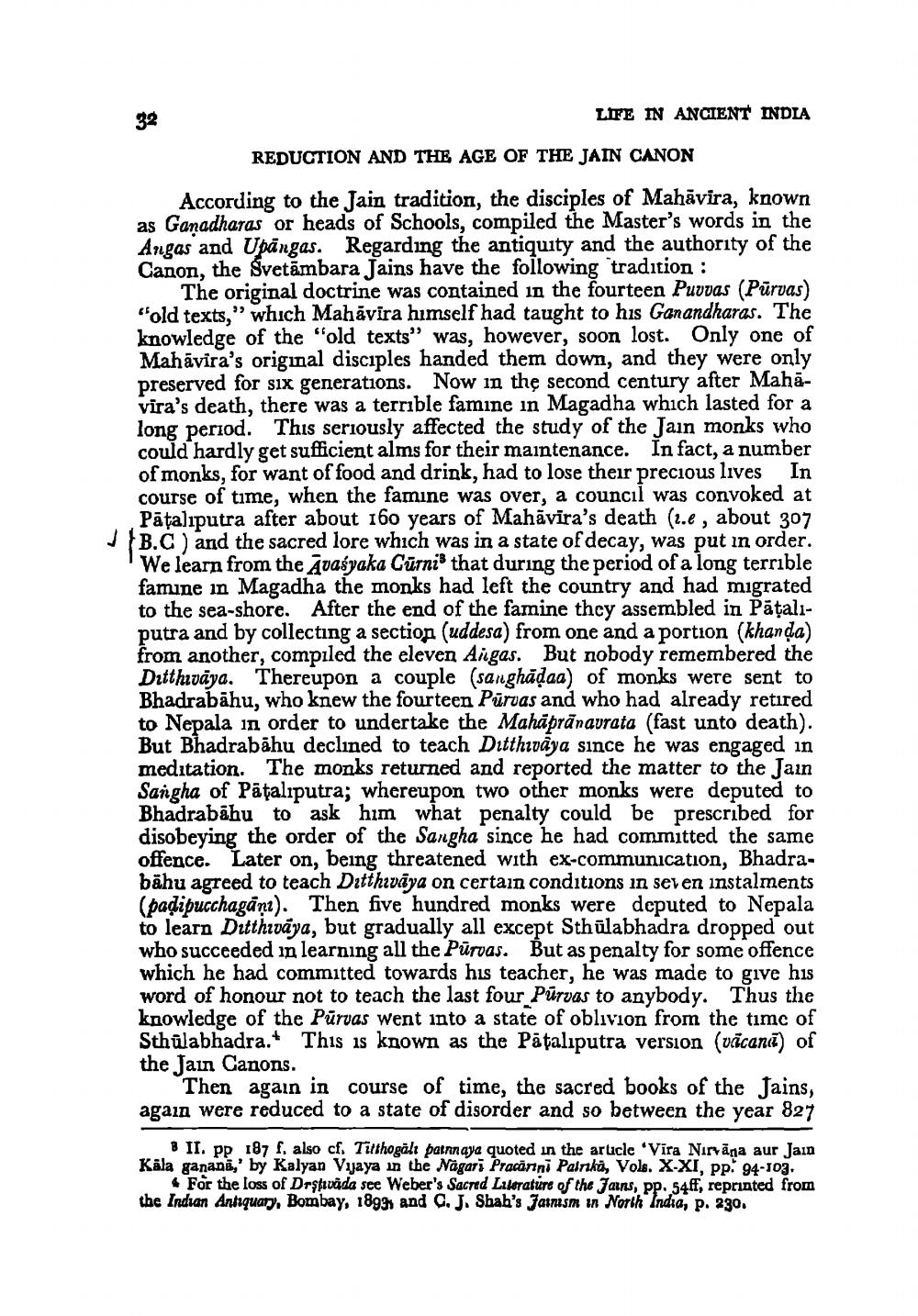________________
LIFE IN ANCIENT INDIA
REDUCTION AND THE AGE OF THE JAIN CANON
V
According to the Jain tradition, the disciples of Mahāvira, known as Ganadharas or heads of Schools, compiled the Master's words in the Angas and Upangas. Regarding the antiquity and the authority of the Canon, the Svetāmbara Jains have the following tradition :
The original doctrine was contained in the fourteen Puvvas (Purvas) "old texts," which Mahăvira himself had taught to his Ganandharas. The knowledge of the "old texts” was, however, soon lost. Only one of Mahāvira's original disciples handed them down, and they were only preserved for six generations. Now in the second century after Mahāvira's death, there was a terrible famine in Magadha which lasted for a long period. This seriously affected the study of the Jain monks who could hardly get sufficient alms for their maintenance. In fact, a number of monks, for want of food and drink, had to lose their precious lives In course of time, when the famine was over, a council was convoked at Pātalıputra after about 160 years of Mahāvira's death (2.e, about 307 B.C) and the sacred lore which was in a state of decay, was put in order. We learn from the Avasyaka Cūrni that during the period of a long terrible famine in Magadha the monks had left the country and had migrated to the sea-shore. After the end of the famine they assembled in Pätalıputra and by collecting a section (uddesa) from one and a portion (khanda) from another, compiled the eleven Aigas. But nobody remembered the Ditthuvāya. Thereupon a couple (sanghādaa) of monks were sent to Bhadrabahu, who knew the fourteen Pūruas and who had already retired to Nepala in order to undertake the Mahaprānaurata (fast unto death). But Bhadrabahu declined to teach Ditthuvāya since he was engaged in meditation. The monks returned and reported the matter to the Jain Sangha of Pataliputra; whereupon two other monks were deputed to Bhadrabāhu to ask him what penalty could be prescribed for disobeying the order of the Sangha since he had committed the same offence. Later on, being threatened with ex-communication, Bhadrabahu agreed to teach Ditthvaya on certain conditions in seven instalments (padipucchagānı). Then five hundred monks were deputed to Nepala to learn Ditthivaya, but gradually all except Sthūlabhadra dropped out who succeeded in learning all the Pūrvas. But as penalty for some offence which he had committed towards his teacher, he was made to give his word of honour not to teach the last four Purvas to anybody. Thus the knowledge of the Purvas went into a state of oblivion from the time of Sthūlabhadra. This is known as the Pätalıputra version (vacant) of the Jain Canons.
Then again in course of time, the sacred books of the Jains, again were reduced to a state of disorder and so between the year 827
B II. pp 187 f. also cf. Titthogält patanaya quoted in the article 'Vira Nirvana aur Jain Kala ganang,' by Kalyan Vijaya in the Nagari Pracanini Palnika, Vols. X-XI, pp. 94-103.
4 For the loss of Drsträda see Weber's Sacred Luleature of the Jarns, pp. 54ff, reprinted from the Indian Antiquary, Bombay, 1892 and C. J. Shah's Jainism in North India, p. 230.




